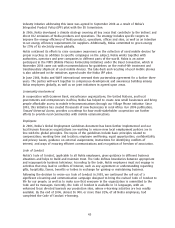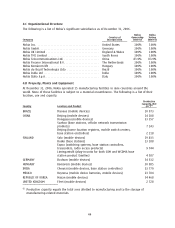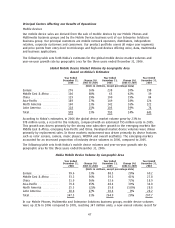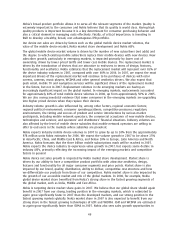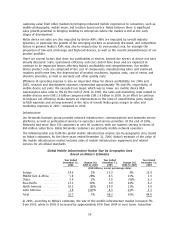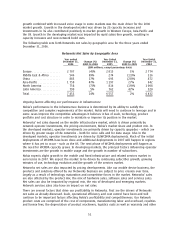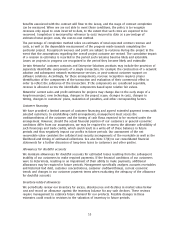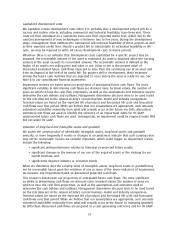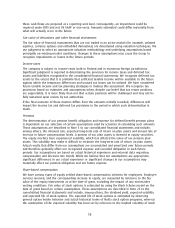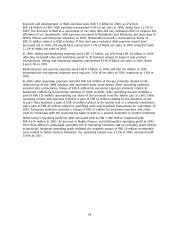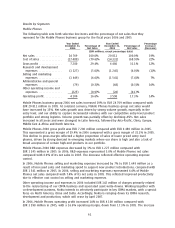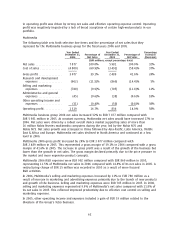Nokia 2006 Annual Report Download - page 53
Download and view the complete annual report
Please find page 53 of the 2006 Nokia annual report below. You can navigate through the pages in the report by either clicking on the pages listed below, or by using the keyword search tool below to find specific information within the annual report.quality costs. Networks profitability is also impacted by the pricing environment, product mix and
regional mix.
In an effort to drive our share and accelerate consolidation of the market we have prioritized
seeking share gains at established operators. However, these actions have resulted in lower margins
or losses initially. In the last few years, we have also prioritized Networks’ sales into the emerging
markets. Networks net sales in the primarily emerging markets of AsiaPacific, Latin America and
Middle East & Africa grew from 28% in 2004 to 42% in 2006 of Networks total net sales. In India, for
example, over the last two years our estimated market share has increased from the single digits to
close to 30% in 2006. During the same two year period, Europe was down from 43% to 36% of
Networks total net sales. Emerging markets, initially and in general, carry lower than average gross
margins for Networks. In addition to growth in emerging markets, Networks’ services business
including services related software, which also carries a lower gross margin than equipment sales,
continued to grow in 2006.
We believe the current and continuing dynamics in the infrastructure market provide further
validation for the creation of Nokia Siemens Networks. This merger is designed to provide the new
company with needed scale and a more competitive convergence portfolio, and we believe it will
further spur industry consolidation. The scale advantages of the merger, coupled with the significant
restructure program planned, are expected to deliver margin benefits leading to improved
profitability. See ‘‘Item 4.B Business Overview—Nokia Siemens Networks’’ for a more detailed
discussion on Nokia Siemens Networks.
Efficiency of operating expense is also an important driver for Networks profitability. For 2006 and
2005, the research and development, or R&D, expenses represented approximately 16% and 18%,
respectively, of Networks net sales. We did not reach our target to lower our Networks R&D
expenses/net sales ratio to 14% by the end of 2006. In 2006, the sales and marketing costs related
to Networks were EUR 544 million compared with EUR 475 million in 2005. In an effort to continue
to improve our efficiency, Nokia targets an improvement in the ratio of overall Nokia gross margin
to R&D expenses and an improvement in the ratio of overall Nokia gross margin to sales and
marketing expenses in 2007, compared to 2006.
Nokia medium term financial targets
In November 2006, Nokia set a target of Nokialevel operating margin of 15% during the next one to
two years. This target revised the one to two year 17% operating margin target Nokia set in
December 2005, primarily due to Nokia’s increased exposure to the infrastructure market following
the expected start of operations of Nokia Siemens Networks. In November 2006, Nokia also set a
Nokia’s device (Mobile Phones and Multimedia combined) operating margin target of 17% during the
next one to two years. This target revised the one to two year 17%18% device operating margin
target Nokia set in December 2005.
Subsequent Event
In June 2006, Nokia and Siemens A.G. (‘‘Siemens’’) announced plans to form Nokia Siemens Networks
that will combine Nokia’s networks business and Siemens’ carrierrelated operations for fixed and
mobile networks in a new company owned by Nokia and Siemens. Nokia and Siemens will each own
approximately 50% of Nokia Siemens Networks. However, Nokia will effectively control Nokia
Siemens Networks as it has the ability to appoint key officers and the majority of the members of its
Board of Directors. Accordingly, Nokia will consolidate Nokia Siemens Networks.
Nokia Siemens Networks operating margin target is 10% plus during the next one to two years as
from the start of operations. Nokia Siemens Networks aims to achieve a double digit operating
margin within its first 12 months of operations, before restructuring charges.
Nokia Siemens Networks is expected to start its operations around the end of March 2007 subject to
the satisfaction or waiver of the conditions to the merger, including achievement of agreement
52



